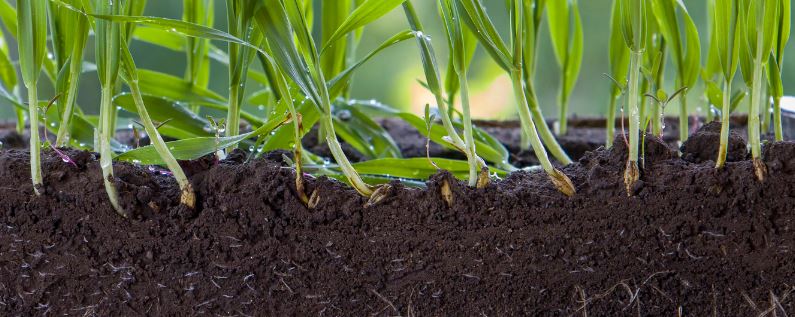

 10:9:30
10:9:30  2024-04-30
2024-04-30  113
113

Modern agricultural science has brought us some super-powered plants, and as we humans are wont to do, we took full credit for these incredible crops.
But a new study from a team led by molecular microbiologist Jacob Malone from the John Innes Center in the UK has found we might not be the only farmers involved in selection of positive traits. Plants themselves are more than capable of tailoring their ecosystem to 'farm' their favored species of microbe.
According to the team's analysis, barley (Hordeum vulgaare) – the crop behind much of the world's beer supply – carefully manages the communities of microbes surrounding its roots by the amount of sugar it releases.
In spite of industrial agriculture's aura of control, it turns out a major dimension of crop breeding has fallen under the scientific radar: the microbiome in the soil directly around a plant's roots, or 'rhizosphere'.
Beneficial microbes can make or break a plant's success. For instance, plants that can harness Pseudomonas bacteria enjoy benefits like enhanced nutrient availability, suppressed pathogens, and primed immune systems.
But Pseudomonas is a fickle friend: it can colonize a wide variety of host plants, so there's competition among plants to rope in the best of these tiny livestock.
Malone's team wanted to find out why and how different barley varieties grown in the same soil environment recruited different beneficial rhizobacteria and fungi.
The experiment involved two cultivars of barley plants: one which is 200-year-old landrace malting barley, Chevallier, and another which is a modern cultivar released in 2004 referred to as Tipple.
Agricultural crops can be loosely categorized as either landraces or modern cultivars. 'LANDRACE' comes from the German word landrasse, meaning 'country-breed', and though its definition is ever-evolving, a landrace crop can loosely be understood as a local species of domesticated plant that has adapted over time to its ecological and cultural environment (and not through deliberate selection).
Modern cultivars, on the other hand, are not necessarily local, have been specifically selected and bred for certain genetic traits, and are sometimes hybridized, often for industrial-level production.
Modern cereal varieties like the Tipple barley "have been intensively bred for positive agricultural traits including high yield and seed starch content, short straw, and good malting properties," the team writes.
"While incorporation of these positive traits has substantially improved yield and crop quality, the wider effect of these changes on plant physiology and ecological impact, and hence the sustainability of the resulting crops, are poorly understood,' they add.
The team grew both kinds of barley from seed for three weeks after germination in a controlled greenhouse lab, and then took a rhizosphere sample from three different plants for each cultivar. After incubating these microbes on agar, they randomly selected 20 isolates per plant, resulting in 120 isolates to represent the rhizospheres of each cultivar.
"We observed distinct differences in the abundance of rhizosphere and root-associated microbes between the two varieties, with Tipple recruiting significantly more pseudomonas bacteria than Chevallier,' the team reports.
They found the plants were recruiting pseudomonas with specific genetic and physical features, much like a human farmer selects their crops based on desired characteristics.
Tipple cultivar plants had higher levels of simple sugars called monosaccharides in their root secretions, favoring pseudomonas adapted to grow on these carbon sources.
On the other hand, the Chevallier roots harbored a far more microbially diverse rhizosphere, a reflection of the plants' complex root secretions. The landrace plants also appeared to have far more control over their 'farm's' soil fungus: Candida species were almost entirely excluded, while Saitozyma species were strongly enriched.
The Tipple plants, on the other hand, appeared to be incapable of influencing the fungi that grew around their roots, resulting in reduced fungal diversity.
"Our results support a cultivar-dependent link between plant growth and the composition of the recruited microbiome, suggesting the microbiome shaping we see here has real consequences for plant health," the team writes, adding that this process is more complex than they previously suspected.
"Determining the extent to which the phenomena we describe here can be observed for crops growing in farm fields is a key challenge for future research," the authors say.
Reality Of Islam |
|
 9:3:43
9:3:43
 2018-11-05
2018-11-05
10 benefits of Marriage in Islam
 7:5:22
7:5:22
 2019-04-08
2019-04-08
benefits of reciting surat yunus, hud &
 9:45:7
9:45:7
 2018-12-24
2018-12-24
advantages & disadvantages of divorce
 11:35:12
11:35:12
 2018-06-10
2018-06-10
 6:0:51
6:0:51
 2018-10-16
2018-10-16
 7:45:39
7:45:39
 2018-06-21
2018-06-21
 10:35:40
10:35:40
 2022-05-26
2022-05-26
 3:18:29
3:18:29
 2022-12-24
2022-12-24
 6:28:21
6:28:21
 2022-12-20
2022-12-20
 11:34:48
11:34:48
 2022-06-29
2022-06-29
the happy life of mankind requirement
 6:36:36
6:36:36
 2022-01-25
2022-01-25
a hero waters thirsty wild animals
 9:4:9
9:4:9
 2022-01-06
2022-01-06
 5:41:46
5:41:46
 2023-03-18
2023-03-18
| LATEST |